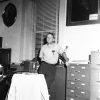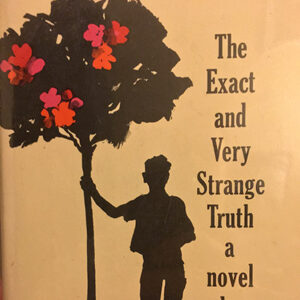calsfoundation@cals.org
The Exact and Very Strange Truth
The Exact and Very Strange Truth is a novel by Little Rock (Pulaski County) native Ben Piazza. It is a fictionalized account of his growing up in Little Rock during the 1930s and 1940s.
Although he earned more acclaim as an actor and director, Piazza had been a writer since his days at Little Rock Central High School, where he edited the literary magazine. While a student at Princeton University, his short story “The Death of Two Kittens” was published in the Nassau Literary Magazine.
He started working on the novel while starring on Broadway in Who’s Afraid of Virginia Woolf? in 1963. During the run of that show, he wrote during the day and performed at night. He finished his novel in the spring of 1964. He later remarked that the first draft was twice as long as the finished novel. Because he was afraid his manuscript might be burned, every day for eight months, when he finished writing for the day, he would put the pages in a box and put it in the ice box.
In advance of the publication of the book, it was excerpted in the July 1964 edition of McCall’s. On September 22, 1964, Piazza appeared on NBC’s The Today Show to discuss the book. Three days later, he made an appearance in Little Rock at the Allsopp and Chapple bookstore for a book signing. The signing was featured in the Arkansas Gazette and the Arkansas Democrat.
The book received generally positive notices—although more than one reviewer noted that it could have used a bit more judicious and skilled editing. Several esteemed authors—including Tennessee Williams, John Steinbeck, and Edward Albee (to whom the book was dedicated)—praised the book; on the heels of Harper Lee’s To Kill a Mockingbird, coming-of-age tales set in the South were in vogue.
Piazza’s novel is a roman à clef (“novel with a key”) for his childhood. While in the introduction he notes that any resemblances to actual people or incidents were irrelevant, the details largely mirror the events in his life. The novel tells the story of a young boy growing up in Little Rock in the 1930s and 1940s. He is the son of an Italian shoemaker and an American housewife and has two sisters and six brothers. Throughout the book, there are references to many bygone Little Rock stores, buildings, and customs.
The novel sold well enough to be issued in paperback after the initial hardback release. The cover of the hardbound edition depicts the silhouette of a young man holding the trunk of a narrow tree, which is also in silhouette; bright leaves dot the tree. When the book was released in paperback, however, it was given a new cover that bears little resemblance to events in the book. It features a boy on the ground reaching up to a girl. At the bottom, the text says: “A novel of the end of innocence, and a youth’s awakening to the world of men and women.” While the book is about the end of innocence, it is not about the end of “innocence” in terms of a sexual awakening.
While Piazza wrote two plays in the late 1960s, this was his only novel.
For additional information:
Green, Rose Basile. The Italian-American Novel: A Document of the Interaction of Two Cultures. Madison, NJ: Fairleigh Dickinson University Press, 1974.
“Little Rock’s Ben Piazza Has Work Which Should Interest the Homefolks.” Arkansas Gazette, August 23, 1964, p. 9E.
Piazza, Ben. The Exact and Very Strange Truth. New York: Farrar, Straus, 1964.
Princeton Alumni Weekly, May 26, 1964, p. 33
Scott Whiteley Carter
Little Rock, Arkansas
 Divergent Prosperity and the Arc of Reform, 1968–2022
Divergent Prosperity and the Arc of Reform, 1968–2022 Literature and Authors
Literature and Authors The Exact and Very Strange Truth
The Exact and Very Strange Truth 




Comments
No comments on this entry yet.